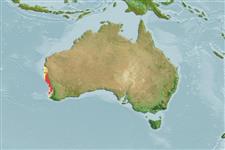Élasmobranches (requins et raies) (sharks and rays) >
Orectolobiformes (Carpet sharks) >
Orectolobidae (Carpet or nurse sharks)
Etymology: Orectolobus: orektos (Gr.), stretched out; lobus (L.), from lobos (Gr.), rounded projection or protuberance, referring to long nasal barbels of Squalus barbatus (=O. maculatus). (See ETYFish); parvimaculatus: parvus (L.), little, referring to its smaller size compared with the similarly spotted O. maculatus. (See ETYFish).
More on authors: Last & Chidlow.
Environment: milieu / climate zone / depth range / distribution range
Écologie
marin démersal; profondeur 9 - 135 m (Ref. 74934). Subtropical
Eastern Indian Ocean: off southwestern Australia.
Length at first maturity / Taille / Poids / Âge
Maturity: Lm ? range ? - 87.6 cm
Max length : 88.5 cm TL mâle / non sexé; (Ref. 74934); 94.3 cm TL (female)
Description synthétique
Morphologie | Morphométrie
This species is characterized by the following features: body coloration variable, rich, brownish, greyish and/or yellowish dorsal colour pattern overlain with dense coverage of pale irregular streaks and large, ring-like ocelli; dorsal fins has alternating dark and light marginal blotches suffused with pale reticulations; dark saddles found on tail converging strongly toward ventral surface; ventral surface of trunk mainly uniformly pale; nasal barbel is bilobed; postspiracular lobes are well-developed, thallate, distance across preorbital group 1.8-2.5 times interspace between preorbital group and postspiracular lobe (PO/PO-PS1), 5.6-8.7 times base length of anterior postspiracular lobe (PO/PS1); base of anterior postspiracular lobe 2.6-4.5 in its distance from postorbital group (PO-PS1/PS1), 1.4-2.6 in its distance from posterior postspiracular lobe (PS1-PS2/PS1); back and above eye without warty tubercles; dorsal fins tall, upright in adult males; first dorsal-fin origin over mid pelvic-fin base; tip of pelvic fin below or slightly forward of insertion of first dorsal fin; interdorsal space 0.6-0.8 times the anal-fin base length; anal-fin inner margin 0.5-0.7 of anal-fin posterior margin; 21-22 teeth in upper jaw, medial row at symphysis of upper jaw absent; 46-49 monospondylous centra; 142-149 total vertebral centra (Ref. 74934).
Life cycle and mating behavior
Maturité | Reproduction | Frai | Œufs | Fécondité | Larves
Last, P.R. and J.A. Chidlow, 2008. Two new wobbegong sharks, Orectolobus floridus sp. nov. and O. parvimaculatus sp. nov. (Orectolobiformes: Orectolobidae), from southwestern Australia. Zootaxa 1673:49-67. (Ref. 74934)
Statut dans la liste rouge de l'IUCN (Ref. 130435)
Menace pour l'homme
Harmless
Utilisations par l'homme
Plus d'informations
PaysZones FAOÉcosystèmesOccurrencesIntroductionsStocksÉcologieRégime alimentaireÉléments du régime alimentaireConsommation alimentaireRation
Taille/ÂgeCroissanceLongueur-poidsLongueur-longueurFréquences de longueursMorphométrieMorphologieLarvesDynamique des populations larvairesRecrutementAbondanceBRUVS
RéférencesAquacultureProfil d'aquacultureSouchesGénétiqueElectrophoresesHéritabilitéPathologiesTraitementNutrientsMass conversion
CollaborateursImagesStamps, Coins Misc.SonsCiguateraVitesseType de nageSurface branchialeOtolithesCerveauxVision
Outils
Articles particuliers
Télécharger en XML
Sources Internet
Estimates based on models
Preferred temperature (Ref.
123201): 17.4 - 22.7, mean 18.3 °C (based on 32 cells).
Phylogenetic diversity index (Ref.
82804): PD
50 = 0.5012 [Uniqueness, from 0.5 = low to 2.0 = high].
Bayesian length-weight: a=0.00389 (0.00180 - 0.00842), b=3.12 (2.94 - 3.30), in cm total length, based on all LWR estimates for this body shape (Ref.
93245).
Niveau trophique (Ref.
69278): 3.9 ±0.6 se; based on size and trophs of closest relatives
Fishing Vulnerability (Ref.
59153): High vulnerability (58 of 100).
